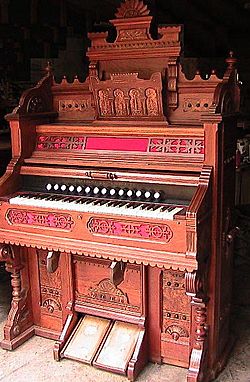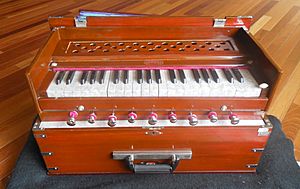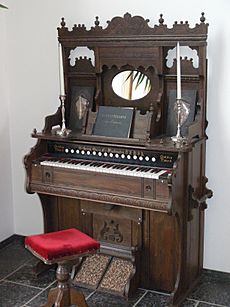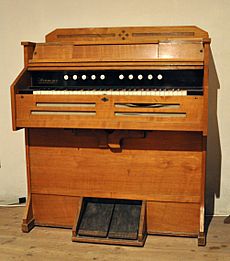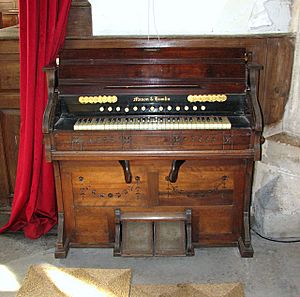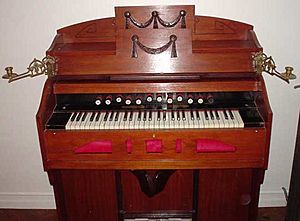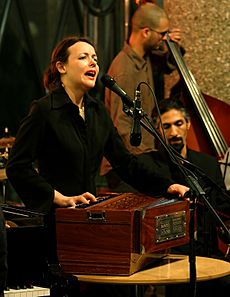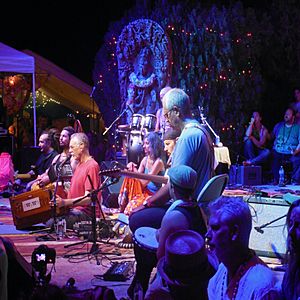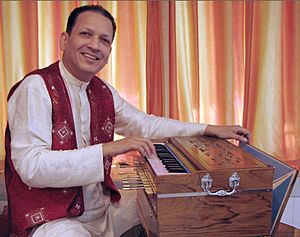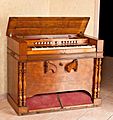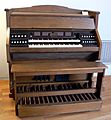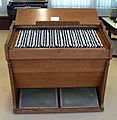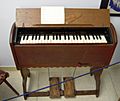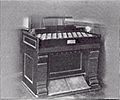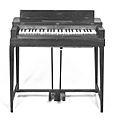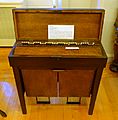Pump organ facts for kids
The pump organ is a type of organ that generates sound as air flows past a vibrating piece of thin metal in a frame. The piece of metal is called a reed. Specific types of pump organ include the reed organ, harmonium, and melodeon.
More portable than pipe organs, free-reed organs were widely used in smaller churches and in private homes in the 19th century, but their volume and tonal range were limited. They generally had one or sometimes two manuals, with pedal-boards being rare. The finer pump organs had a wider range of tones, and the cabinets of those intended for churches and affluent homes were often excellent pieces of furniture. Several million free-reed organs and melodeons were made in the US and Canada between the 1850s and the 1920s. During this time Estey Organ and Mason & Hamlin were popular manufacturers.
Contents
History
Christian Gottlieb Kratzenstein (1723–1795), professor of physiology at Copenhagen, was credited with the first free-reed instrument made in the Western world, after winning the annual prize in 1780 from the Imperial Academy of St. Petersburg. The harmonium's design incorporates free reeds and derives from the earlier regal. A harmonium-like instrument was exhibited by Gabriel-Joseph Grenié (1756–1837) in 1810. He called it an orgue expressif (expressive organ), because his instrument was capable of greater expression, as well as of producing a crescendo and diminuendo. Alexandre Debain improved Grenié's instrument and gave it the name harmonium when he patented his version in 1840. There was concurrent development of similar instruments. A mechanic who had worked in the factory of Alexandre in Paris emigrated to the United States and conceived the idea of a suction bellows, instead of the ordinary bellows that forced the air outward through the reeds. Beginning in 1885, the firm of Mason & Hamlin, of Boston made their instruments with the suction bellows, and this method of construction soon superseded all others in America.
Harmoniums reached the height of their popularity in the West in the late 19th and early 20th centuries. They were especially popular in small churches and chapels where a pipe organ would be too large or expensive; in the funeral-in-absentia scene from Mark Twain's The Adventures of Tom Sawyer, the protagonist narrates that the church procured a "melodeum" (a conflation, likely intended by Twain for satirical effect, of the names "melodeon" and "harmonium") for the occasion. Harmoniums generally weigh less than similar sized pianos and are not easily damaged in transport, thus they were also popular throughout the colonies of the European powers in this period not only because it was easier to ship the instrument out to where it was needed, but it was also easier to transport overland in areas where good-quality roads and railways may have been non-existent. An added attraction of the harmonium in tropical regions was that the instrument held its tune regardless of heat and humidity, unlike the piano. This "export" market was sufficiently lucrative for manufacturers to produce harmoniums with cases impregnated with chemicals to prevent woodworm and other damaging organisms found in the tropics.
At the peak of the instruments' Western popularity around 1900, a wide variety of styles of harmoniums were being produced. These ranged from simple models with plain cases and only four or five stops (if any at all), up to large instruments with ornate cases, up to a dozen stops and other mechanisms such as couplers. Expensive harmoniums were often built to resemble pipe organs, with ranks of fake pipes attached to the top of the instrument. Small numbers of harmoniums were built with two manuals (keyboards). Some were even built with pedal keyboards, which required the use of an assistant to run the bellows or, for some of the later models, an electrical pump. These larger instruments were mainly intended for home use, such as allowing organists to practise on an instrument on the scale of a pipe organ, but without the physical size or volume of such an instrument. For missionaries, chaplains in the armed forces, travelling evangelist etc., reed organs that folded up into a container the size of a very large suitcase or small trunk were made; these had a short keyboard and few stops, but they were more than adequate for keeping hymn singers more or less on pitch.
The invention of the electronic organ in the mid-1930s spelled the end of the harmonium's success in the West, although its popularity as a household instrument had already declined in the 1920s as musical tastes changed . The Hammond organ could imitate the tonal quality and range of a pipe organ whilst retaining the compact dimensions and cost-effectiveness of the harmonium as well as reducing maintenance needs and allowing a greater number of stops and other features. By this time, harmoniums had reached high levels of mechanical complexity, not only through the demand for instruments with a greater tonal range, but also due to patent laws (especially in North America). It was common for manufacturers to patent the action mechanism used on their instruments, thus requiring any new manufacturer to develop their own version;{{cn}{ as the number of manufacturers grew, this led to some instruments having hugely complex arrays of levers, cranks, rods and shafts, which made replacement with an electronic instrument even more attractive.
The last mass-producer of harmoniums in North America was the Estey company, which ceased manufacture in the mid-1950s; a couple of Italian companies continued into the 1970s. As the existing stock of instruments aged and spare parts became hard to find, more and more were either scrapped or sold. It was not uncommon for harmoniums to be "modernised" by having electric blowers fitted, often very unsympathetically. The majority of Western harmoniums today are in the hands of enthusiasts, though the instrument still remains popular in South Asia.
Modern electronic keyboards can emulate the sound of the pump organ.
Repertory
The harmonium was somewhat embraced by European and American composers of classical music. It was also used often in the folk music of the Appalachians and South of the United States.
Harmoniums played a significant part in the new rise of Nordic folk music, especially in Finland. In the late 1970s, a harmonium could be found in most schools where the bands met, and it became natural for the bands to include a harmonium in their setup. A typical folk band then—particularly in Western Finland—consisted of violin(s), double-bass and harmonium. There was a practical limitation that prevented playing harmonium and accordion in the same band: harmoniums were tuned to 438 Hz, while accordions were tuned to 442 Hz. Some key harmonium players in the new rise of Nordic folk have been Timo Alakotila and Milla Viljamaa.
In the Netherlands, the introduction of the harmonium triggered a boom in religious house music. Its organ-like sound quality allowed Reformed families to sing psalms and hymns at home. A lot of new hymns were composed expressly for voice and harmonium, notably those by Johannes de Heer.
Western classical
The harmonium repertoire includes many pieces written originally for the church organ, which may be played on a harmonium as well, because they have a small enough range and use fewer stops. For example, Bach's Fantasia in C major for organ BWV 570 is suitable for a four-octave harmonium.
- Alban Berg. Altenberg Lieder
- William Bergsma. Dances from a New England Album, 1856 for orchestra. It includes parts for melodeon (movements I-III) and harmonium (movement IV).
- William Bolcom. Songs of Innocence and of Experience for orchestra, choirs, and soloists, includes parts for melodeon, harmonica, and harmonium.
- Anton Bruckner. Symphony no. 7, an arrangement for chamber ensemble, prepared in 1921 by students and associates of Arnold Schoenberg for the Viennese Society for Private Musical Performances, was scored for two violins, viola, cello, bass, clarinet, horn, piano 4-hands, and harmonium. The Society folded before the arrangement could be performed, and it went without premiere for more than 60 years.
- Frederic Clay. Ages Ago, an early work that features a harmonium part (libretto by W. S. Gilbert).
- Claude Debussy. Prélude à l'après-midi d'un faune, a chamber ensemble arrangement by Arnold Schoenberg.
- Antonín Dvořák. Five Bagatelles for two violins, cello and harmonium, Op. 47 (B.79).
- Edward Elgar. Sospiri, Adagio for String Orchestra, Op. 70 (scored for harp or piano and harmonium or organ). Vesper Preludes.
- César Franck. The final collection of pieces popularly known as L'Organiste (1889–1890) was actually written for harmonium, some pieces with piano accompaniment.
- Alexandre Guilmant, author of many duos for piano and harmonium, including:
- Symphonie tirée de la Symphonie-Cantate "Ariane" (Op. 53)
- Pastorale A-Dur (Op. 26)
- Finale alla Schumann sur un noël languedocien (Op. 83)
- Paul Hindemith. Hin und zurück (There and Back), an operatic sketch that uses a harmonium for its stage music.
- Sigfrid Karg-Elert. Various works for solo harmonium.
- Kronos Quartet. Early Music, an album that has several pieces featuring harmonium.
- Henri Letocart (1866–1945). 25 pieces for harmonium, Premier cahier.
- Franz Liszt. Symphonie zu Dantes Divina Commedia, Movement II: Purgatorio
- Gustav Mahler. Symphony No. 8
- George Frederick McKay. Sonata for Clarinet and Harmonium (1929) (also adaptable to piano or violin)
- Martijn Padding. First Harmonium Concerto (2008) for harmonium and ensemble
- Gioachino Rossini. Petite messe solennelle is scored for twelve voices, two pianos and harmonium.
- Camille Saint-Saëns. The Barcarolle, Op. 108 is scored for piano, harmonium, violin and cello.
- Arnold Schoenberg
- Franz Schreker. Chamber Symphony
- Richard Strauss. Ariadne auf Naxos an opera (libretto by Hugo von Hofmannsthal) that employs a harmonium in the orchestration of each of its versions. It requires an instrument with many stops, which are specified in the score.
- Louis Vierne. 24 Pièces en style libre pour orgue ou harmonium, Op. 31 (1913)
- Alexander Zemlinsky
- Six Maeterlinck Songs
- Lyric Symphony
Western popular music
Harmoniums have been used in western popular music since at least the 1960s. John Lennon played a Mannborg harmonium on the Beatles' hit single "We Can Work It Out", released in December 1965, and the band used the instrument on other songs recorded during the sessions for their Rubber Soul album. They also used the instrument on the famous "final chord" of "A Day in the Life", and on the song "Being for the Benefit of Mr. Kite!", both released on the 1967 album Sgt. Pepper's Lonely Hearts Club Band. The group's hit single "Hello, Goodbye" and the track "Your Mother Should Know" were both written using a harmonium.
Many other artists soon employed the instrument in their music, including; Pink Floyd on the title song "Chapter 24" of their first album The Piper at the Gates of Dawn in 1967, Elton John on his 1973 album Don't Shoot Me I'm Only the Piano Player, 1976's Blue Moves, the 1978 album A Single Man, and 1995's Made in England, and in more recent times Greg Weeks and Tori Amos on their recordings and live performances. German singer Nico was closely associated with the harmonium, using it as her main instrument, during the late 60s and 70s, on albums such as The Marble Index, Desertshore and The End.... Donovan employed the harmonium on his 1968 album "The Hurdy Gurdy Man" where he played it in droning accompaniment on the song Peregrine, and where it was also played on his song Poor Cow by John Cameron. Roger Hodgson from Supertramp used his harmonium on many of the group's songs including Two of Us from Crisis? What Crisis?, Fool's Overture from Even in the Quietest Moments..., the title track to their 1979 album Breakfast in America and Lord Is It Mine. Hodgson used also used a harmonium on The Garden from his 2000 solo album Open the Door. The band Blind Pilot also used a harmonium in their song "New York". In 1990, Depeche Mode (band) used a harmonium on a version of their song ‘’Enjoy The Silence’’. The Divine Comedy used a harmonium on Neptune's Daughter from their 1994 album Promenade. Sara Bareilles used the harmonium on her 2012 song "Once Upon Another Time."
The harmonium has become a mainstay instrument of Hindu and Sikh-based devotional mantra music known as kirtan, a 7th-8th century Indian music, which popularly emerged in the west during in the 1990s. Within this style of music the harmonium is often played as the lead instrument by many kirtan artists; notably Jai Uttal who was nominated for a Grammy award for new-age music in 2004, Snatam Kaur, and Krishna Das who was nominated for a Grammy award for new age music in 2012.
In the Indian subcontinent
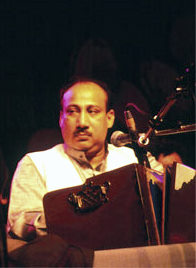
The harmonium is popular to the present day, and the harmonium remains an important instrument in many genres of Indian subcontinent. For example, it is a staple of vocal North Indian classical music, Bengali Music and Sufi Muslim Qawwali concerts. It is commonly found in Indian and Bangladeshi homes. Though derived from the designs developed in France, the harmonium was developed further in Bengal in unique ways, such as the addition of drone stops and a scale-changing mechanism. In Bengal, Dwarkanath Ghose of the Dwarkin company modified the imported harmony flute and developed the hand-held harmonium, which has subsequently become an integral part of the Indian music scene. Dwijendranath Tagore, a Bengali, is credited with having used the imported instrument in 1860 in his private theatre, but it was probably a pedal-pumped instrument that was cumbersome or possibly some variation of the reed organ. Initially it aroused curiosity, but gradually people started playing it, and Ghose took the initiative to modify it. It was in response to the Indian needs that the hand-held harmonium was introduced. All Indian musical instruments are played with the musician sitting on the floor or on a stage, behind the instrument or holding it in his hands. In that era, Indian homes did not use tables and chairs. Also, Western music being harmonically based, both a player's hands were needed to play the chords, thus assigning the bellows to the feet was the best solution; Indian music, being melodically based, only one hand was necessary to play the melody, and the other hand was free for the bellows.
The harmonium was widely accepted in Indian music, particularly Parsi and Marathi stage music, in the late 19th century. By the early 20th century, however, in the context of nationalist movements that sought to depict India as utterly separate from the West, the harmonium was portrayed as an unwanted foreigner. Technical concerns with the harmonium included its inability to produce meend (slides between notes) which can be done in instruments like Sitar and Tanpura, and the fact that, once tuned, it cannot be adjusted in the course of performance. The former prevents it from articulating the subtle inflections (such as andolan, gentle oscillation) so crucial to many ragas; the latter prevents it from articulating the subtle differences in intonational color between a given svara in two different ragas. For these reasons, it was banned from All India Radio from 1940 to 1971; a ban still stands on harmonium solos. On the other hand, many of the harmonium's qualities suited it very well for the newly reformed classical music of the early 20th century: it is easy for amateurs to learn; it supports group singing and large voice classes; it provides a template for standardized raga grammar; it is loud enough to provide a drone in a concert hall. For these reasons, it has become the instrument of choice for accompanying most North Indian classical vocal genres, with top vocalists (e.g., Bhimsen Joshi) routinely using harmonium accompaniment in their concerts. However, it is still despised by some connoisseurs of Indian music, who prefer the sarangi as an accompanying instrument for khyal singing.
A popular usage is by followers of the Hindu and Sikh faiths, who use it to accompany their devotional songs (bhajan and kirtan) respectively . There is at least one harmonium in any mandir (Hindu temple) and gurdwara(Sikh temple) around the world. The harmonium is commonly accompanied by the tabla as well as a dholak. To Sikhs, the harmonium is known as the vaja or baja. It is also referred to as a peti (literally, box) in some parts of North India and Maharashtra. The harmonium plays an integral part in Qawwali music. Almost all Qawwals use the harmonium as their sole musical accompaniment. It has received international exposure as the genre of Qawwali music has been popularized by renowned Pakistani musicians, including Nusrat Fateh Ali Khan. There is some discussion of Indian harmonium makers producing reproductions of Western-style reed organs for the export trade.
Vidyadhar Oke has developed a 22-microtone harmonium, which can play 22 microtones as required in Indian classical music. The fundamental tone (Shadja) and the fifth (Pancham) are fixed, but the other ten notes have two microtones each, one higher and one lower. The higher microtone is selected by pulling out a knob below the key. In this way, the 22-shruti harmonium can be tuned for any particular raga by simply pulling out knobs wherever a higher shruti is required.
Bhishmadev Vedi is said to have been the first to contemplate improving the harmonium by augmenting it with a swarmandal (harp-like string box) attached to the top of the instrument. His disciple, Manohar Chimote, later implemented this concept, also making the instrument more responsive to key pressure, and called the instrument a samvadini—a name now widely accepted. Bhishmadev Vedi is also said to have been among the first to contemplate and design compositions specifically for the harmonium, styled along the lines of "tantakari"—performance of music on stringed instruments. These compositions tend to have a lot of cut notes and high-speed passages, creating an effect similar to that of a string being plucked.
In 1954, Late Jogesh Chandra Biswas first modified the then-existing Harmoniums, so it folds down into a much thinner space for easier-maneuverability. Prior to that, if the instrument was boxed, it used to need 2 people to carry it, holding it from either side. This improvisation became a generic design in most harmoniums since then and coined with the term "Folding Harmoniums".
See also: the Shruti box, a keyless harmonium used only to produce drones to support other soloists.
Types
In the view points of maintenance and restoration, the pump organs are often categorized into several types.
Historical instruments
-
cf. Positive organ
(small pipe organ with bellows) -
cf. Portative organ
(portable pipe organ with bellows) -
Regal without pipes (beating reed organ, without pipes after the 16th century)
-
cf. Accordion circa 1830 (invented c.1822/1829)
Harmoniums (pressure system free-reed organs)
Suction reed organs (vacuum system free-reed organs)
Melodeons
Reed organs
Later instruments (electrically-blown / electronic organs)
-
Electrostatic-pickup reed organ (1930s–60s)
-
cf. Electronic organ (1939–)
Images for kids
See also
 In Spanish: Armonio para niños
In Spanish: Armonio para niños


